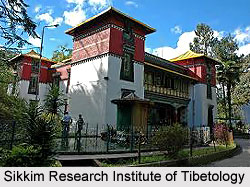 Sikkim Research Institute of Tibetology located in Gangtok, the capital of Sikkim is one of the well regarded institutions in India. It is perched on a hill and was established in the year 1958. The institute was set up for conducting research programmes on language and traditions of Tibet as well as Mahayana sect of Buddhism. The institute also has a museum, a Tibetian library and a general reference centre. It promotes research on different subjects like history, language, art and culture of Sikkim. Earlier it was known as Namgyal Institute of Tibetology.
Sikkim Research Institute of Tibetology located in Gangtok, the capital of Sikkim is one of the well regarded institutions in India. It is perched on a hill and was established in the year 1958. The institute was set up for conducting research programmes on language and traditions of Tibet as well as Mahayana sect of Buddhism. The institute also has a museum, a Tibetian library and a general reference centre. It promotes research on different subjects like history, language, art and culture of Sikkim. Earlier it was known as Namgyal Institute of Tibetology.
History of Sikkim Research Institute of Tibetology
The site for the Sikkim Research Institute of Tibetology was donated by the late Chogyal (king) of Sikkim Sir Tashi Namgyal in memory of his departed son Paljor Namgyal. The foundation stone of the institute was laid by the 14th Dalai Lama on the 10th of February 1957 and the institute was declared open by the late Prime Minister of India Pandit Jawaharlal Nehru on the 1st of October 1958. It is an imposing monument and stands as a magnificent example of Sikkimese architecture. The institute was earlier named as Namgyal Institute of Tibetology in memory of Late Palden Thondup Namgyal (the Chogyal of Sikkim). The Institute was the great invention made by him. It is a beautiful monument built in typical Buddhist style. It stands as a magnificent example of Sikkimese architecture. The balcony is adorned with striking wall paintings.
Museum of Sikkim Research Institute of Tibetology
The museum of Sikkim Research Institute of Tibetology located on the ground floor houses rare manuscripts on the theme of Mahayana Buddhism. Apart from these it also has an amazing collection of more than 200 Buddhist icons, traditional art objects, antique paintings, ritual objects, thangkas i.e. painted, woven, and embroidered scrolls, statues, shrines, tapestries, masks and other religious works of Tibetan Art. It also displays a majestic silver image of Manjusri, the Bodhisattva of knowledge. The museum also has a silver casket that houses the relics of two great Asokan missionaries, Madhyama and Kasyapagotra. One can also see five great sandalwood images of Padmasambhava, the three founding lamas of Sikkim and the first king Puntsok Namgyal. The museum is regarded as one of the best places for the study of Buddhist philosophy and religion. A library is also located on the first floor of the Sikkim Research Institute of Tibetology. It has a large collection of books on Buddhism.
Sikkim Research Institute of Tibetology had published the Bulletin of Tibetology since 1964 and numerous books over the years. It has not less than 30,000 volumes as well as translations of the original teachings of the Gautama Buddha and discourses by other eminent Buddhist scholars from different parts of the world. In 2002 the institute undertook to expand the institute. It also gone for international collaboration and organizes new research programs, lectures, seminars, fellowship programs, publications and collaboration with foreign scholars. The institute has initiated new research programs to document the social history of Sikkim`s 60 monasteries and digitize their textual holdings. The Visual Sikkim project undertook to locate, digitalize and document old and rare photographs of Sikkim, both in India and abroad. Sikkim Research Institute of Tibetology is thus a storehouse of knowledge where tourists can gather immense knowledge about Buddhist culture and traditions.






